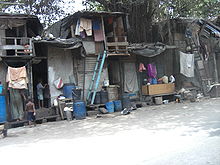
Back الإسكان غير القانوني في الهند Arabic भारत में अवैध आवास Hindi Незаконне житлове будівництво в Індії Ukrainian

Illegal housing in India consists of huts or shanties built on land not owned by the residents (i.e., squatting) and illegal buildings constructed on land not owned by the builders or developers. Although illegal buildings may afford some basic services, such as electricity, in general, illegal housing does not provide services that afford for healthy, safe environments.
Collapses of illegal buildings made with inadequate building supplies and practices may result in the deaths of their occupants. A recent example is the 4 April 2013 collapse of an eight-story building in the Shil Phata area of Mumbra, in the greater Mumbai area; 72 people were killed in the collapse.
Strategies to curb or mitigate illegal housing include creating more affordable housing structures, redeveloping the safe illegal buildings, developing a plan of action for residents of shanties or illegal buildings, and policing the construction of illegal buildings or shanties.

- ^ Sharad Vyas; Surendra Gangan (4 April 2006). "Wadala slums seek help". DNA. Retrieved 25 June 2009.[permanent dead link]